
Berkeley Plantation, one of the first plantations in America, comprises about 1,000 acres (400 ha) on the banks of the James River on State Route 5 in Charles City County, Virginia. Berkeley Plantation was originally called Berkeley Hundred and named after the Berkeley Company of England. In 1726, Benjamin Harrison IV built on the estate one of the first three-story brick mansions in Virginia. It is the ancestral home to two presidents of the United States: William Henry Harrison, and his grandson Benjamin Harrison. It is now a museum property, open to the public.
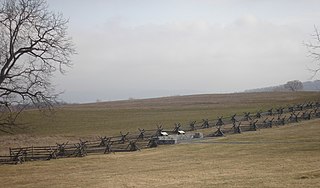
Antietam National Battlefield is a National Park Service-protected area along Antietam Creek in Sharpsburg, Washington County, northwestern Maryland. It commemorates the American Civil War Battle of Antietam that occurred on September 17, 1862.

19th Century Willowbrook Village was an open-air museum encompassing a former 19th-century village in Newfield, Maine. It is located north of the town center on Elm Street, on approximately 10 acres (4.0 ha), with 34 buildings. It was open 10 a.m. to 5 p.m., 5 days each week from the Saturday of Memorial Day weekend through October, closed Tuesdays and Wednesdays. Much of the museum property is listed on the National Register of Historic Places as the Newfield (Willowbrook) Historic District.

A round barn is a historic barn design that could be octagonal, polygonal, or circular in plan. Though round barns were not as popular as some other barn designs, their unique shape makes them noticeable. The years from 1880–1920 represent the height of round barn construction. Round barn construction in the United States can be divided into two overlapping eras. The first, the octagonal era, spanned from 1850–1900. The second, the true circular era, spanned from 1889–1936. The overlap meant that round barns of both types, polygonal and circular, were built during the latter part of the nineteenth century. Numerous round barns in the United States are listed on the National Register of Historic Places.
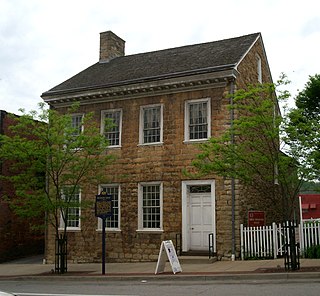
The David Bradford House is a historic house museum at 175 South Main Street in Washington, Pennsylvania. Completed in 1788, it was the home of David Bradford, a leader of the Whiskey Rebellion. It has both architectural and historic importance, and was designated a National Historic Landmark in 1983. It is open weekly between April and November, or by appointment.

Woodville, also known as the Neville House or John Neville House, is a house on Washington Pike south of Heidelberg, Pennsylvania. It is significant for its association with John Neville, a tax collector whose other house was burned in the Whiskey Rebellion in 1794. The oldest portion of the house dates to 1775, with a main section built a decade later. It is one of the oldest houses in Allegheny County, preserved and restored to its original condition.

Trumpington is a historic home located at Rock Hall, Kent County, Maryland. Its Georgian plan main house is of Flemish bond brick construction five bays long, two rooms deep, and two and a half stories high. A 1 1⁄2-story brick wing is attached. Also on the property is a log plank meathouse, a 19th-century granary, a small cemetery, a 20th-century barn, and mid-20th-century frame cottage.
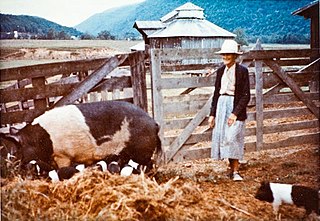
The Kuykendall Polygonal Barn was an early 20th-century polygonal barn in the South Branch Potomac River valley near Romney in Hampshire County, West Virginia. The Kuykendall Polygonal Barn was the only 15-sided barn built in West Virginia, and one of only a few such known to have been constructed in the United States. The barn utilized a number of sophisticated technological innovations not found in West Virginia's other round and polygonal barns. The Kuykendall Polygonal Barn was listed on the National Register of Historic Places on 9 July 1985.
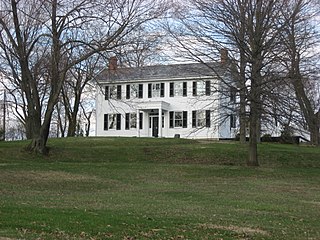
The James Beach Clow House is a historic house in northern Beaver County, Pennsylvania, United States. Located in North Sewickley Township near the community of Ellwood City, the house is a rare surviving example of 19th-century Greek Revival farmhouses in Beaver County.
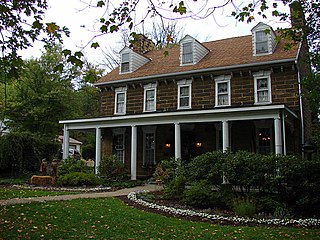
Hill's Tavern is a historic building in Scenery Hill, Pennsylvania. It was heavily damaged by a fire that started shortly before midnight on August 17, 2015. For a period in the early 1900s, the inn was known as Central Hotel. Now called the Century Inn, it has been claimed to have been the oldest tavern in continuous use on the National Road, until the fire brought an end to its 221 years of continuous operation.

Huffman Distillery and Chopping Mill is a historic complex of buildings in Somerset Township, Washington County, Pennsylvania. Contributing buildings include a c. 1810 2 1⁄2-story four-bay brick main house; a c. 1815 timber-frame bank barn; a c.1790 stone-and-log distillery, and a c. 1805 timber-frame chopping mill. The mill was horse powered, and was used to chop grain for the distilling process. These buildings are a rare surviving example of an important industry in the Somerset Township area, and the very small-scale industrial/commercial enterprises of the late 18th/early 19th centuries. The area had a high concentration of distillers, and they were greatly affected by the whiskey excise tax and the Whiskey Rebellion.
This is a list of the National Register of Historic Places listings in Cuyahoga Valley National Park.

Farmer's Delight was built in Loudoun County, Virginia in 1791 by Colonel Joseph Flavius Lane. The Federal style brick plantation house incorporates elements of Georgian architecture. The house is now closely associated with American oilman and diplomat George C. McGhee, who owned the property after 1948. The house is maintained by the McGhee Foundation and is listed on the National Register of Historic Places.

John Douglass House, also known as the Governor Sproul Birthplace, is a historic home located at Colerain Township in Lancaster County, Pennsylvania. It is a 2 1/2-story, five bay stone dwelling with a center hall plan in the Georgian style. The house was built about 1769, with a remodeling sometime after 1815 when a summer kitchen was added and the original walk-in fireplace was filled in. The property was restored in 2007. Also on the property are a contributing bank barn, log smokehouse, and the ruins of a stone carriage shed. It was the birthplace of Pennsylvania Governor William Cameron Sproul (1870–1928).

Springton Manor Farm is a historic farm and national historic district located in Wallace Township, Chester County, Pennsylvania. The farm has 14 contributing buildings, 1 contributing site, and 5 contributing structures. They include the main house, a cistern, tool shed, privy, spring and milk house, carriage house, small barn, corn crib, bank barn, stone lean-to, the ruins of a stone spring house, and hydraulic dams. The main house is in three sections; the earliest dates about 1836, with additions and modifications made in 1887 and 1912. It is a 2 1/2-story, seven bay by two bay, stuccoed stone dwelling with Georgian and Queen Anne style design details. Originally built by Joseph Muckleduff in the early 1700s. Upon Joseph's death 9 Sep 1750, Springton Manor was left to his brother Samuel Muckleduff. [Chester Co PA Wills & Mention in Wills 1713 - 1825]. It was the home of Congressman Abraham Robinson McIlvaine (1804-1863). The property is administered as a park and agricultural history museum by Chester County.

The Oxford Horse Barn, built in 1887, is located near Laramie, Wyoming in Albany County, Wyoming. It is one of the oldest and largest existing barns in Albany County. The barn in an excellent example of vernacular architecture as influenced by the English cattle and horse ranchers which immigrated to the American West. It is listed on the National Register of Historic Places.
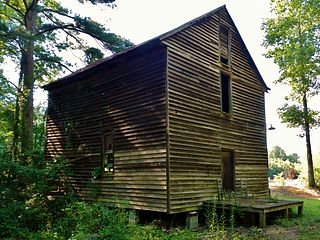
Boyd Mill Place, also known as Davenport's Mill and Hearon's Mill, is the site of a historic grist mill constructed circa 1870 in Weston, Georgia in Webster County, Georgia. The mill was built by John Boyd and operated from c.1870 to 1963. Water supply for the mill is behind a 400 feet (120 m) earthen dam.

Midway Stock Farm Barn was a historic building located north of Keosauqua, Iowa, United States. The barn was built by William A. Barker around 1880. It gained historical significance when his son Webb installed equipment made by the Louden Machinery Company of Fairfield, Iowa. By doing so he converted the facility from one that raised livestock to a dairy operation. Around 1918 Barker built an addition onto the south side of the barn and installed a litter carrier with tracks and switches on the ground floor, a hay carrier with a steel track and grapple hook hay fork also on the main floor, and a metal aerator on the roof. It was one of a few local operations that still had the Louden equipment in place.

The C.D. and Eliza Heath Bevington Privy is a historic building located in Winterset, Iowa, United States. Bevington was a pharmacist who passed through the area in 1849 on his way to the California Gold Rush. He settled in Winterset in 1853 after he made his fortune, and worked as a real estate agent, farmer, livestock dealer, and banker. The 7.5-by-10.33-foot structure is composed of roughly squared quarry faced rubble that is laid in a two against one bond. There is a stone vault with a depth of 6 feet (1.8 m) beneath the entire structure. The privy served the C.D. Bevington House. It was listed on the National Register of Historic Places in 1987. It is now part of a museum complex operated by the Madison County Historical Society.



















